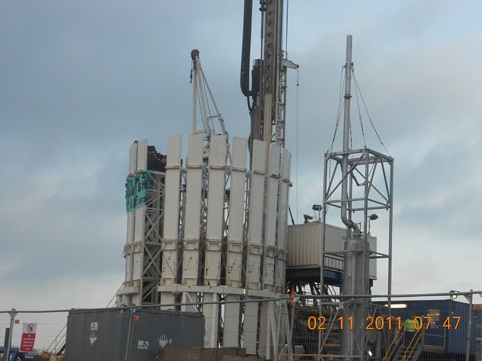The seismic activity occurred when Cuadrilla injected water and chemicals at high pressure — the key part of the fracking process to release shale gas — directly into a tectonic fault that, very unusually for a geological feature of this kind, had some natural permeability.
It was the fact that the fault accepted the fluid that caused the earth tremors, and Stefan Baisch, one the report’s authors and general manager of German deep-drilling research firm Q-Con, told The Engineer it had been a worst-case scenario for Cuadrilla.
‘There have been more than a million similar treatment operations in the world over the last 50 years or so and there are only two cases where similar seismic reactions occurred,’ said Baisch, who has a PhD in seismology and has spent 10 years researching induced seismicity.
‘With hindsight, Preese Hall-1 [might] not have been picked because of seismic risk concerns.’
Stefan Baisch, Q-Con
‘With hindsight, with our knowledge now that a fault in the Bowland shale can react like this, it might have been possible that the Preese Hall-1 [well site] would not have been picked because of seismic risk concerns.’
But the rarity of such an event meant that fracking-induced seismic activity was not seen as a concern before drilling started, he said. Although there is a chance the fault could have been detected with a seismic pre-survey, it wouldn’t have provided a 100 per cent guarantee of identifying it unambiguously.
However, Prof Stuart Haszeldine, a geologist at Edinburgh University pointed to the relatively high amount of stress in UK rockbeds.
‘That stress often needs just a small trigger to make a small earthquake,’ he said. ‘It’s also very hard to see where pre-existing faults are deep down in this location, so predicting how to stay away from future faults is very difficult indeed.
‘Although this is a very thorough report, I would be very cautious before proceeding with more commercial drilling. More measurements of deep present-day stresses at different locations in the basin are needed to enable more accurate predictions.’
’Traffic light’ warning system
The answer, according to the Cuadrilla-commissioned report, is to use smaller volumes of fluid and to deploy sensitive seismic monitors just below the surface in the area around any future well sites to act as a ‘traffic light’ warning system if seismic activity reaches a threshold of 1.7 on the Richter scale.
Given that any seismic activity is likely to be bigger the further into the rock the fracking fluid progresses, such monitoring should provide an early warning if minor tremors are detected and the operation can be halted and the pressure released before stronger activity occurs.
These systems have been used to monitor gas exploitation in the Netherlands and have become mandatory in some German states for geothermal drilling, but while they are increasingly widely used, they are not yet a standard precaution for fracking.

Baisch said that using such a traffic light would provide extra reassurance that fracking was safe with regards to seismic activity.
‘If we don’t know with a 100 per cent guarantee, we put in an extra safety factor,’ he said. ‘There’s always some uncertainty with sub-surface parameters, and with this traffic light system we are sure, even if our expectations about the geological conditions are wrong, that nothing could happen.’
Quake magnitude
Even if further seismic activity were to occur due to fracking, the report also says that it would only ever reach 3 on the Richter scale. The largest event recorded in Lancashire was 2.3 on the scale.
Dr Brian Baptie, head of earthquake seismology at the British Geological Survey, said: ‘The proposed maximum acceptable earthquake of a magnitude 2.6 earthquake might, at a depth of 3km, result in an intensity of shaking that would not be expected to cause any damage but would be widely felt by people indoors and out, and may displace objects on shelves.’
’A passing train would be more noticeable.’
Prof Quentin Fisher, Leeds University
Prof Quentin Fisher, professor of petroleum geoengineering at Leeds University, went a step further and said: ‘Although hydraulic fracturing always causes microseismic events (i.e. low magnitude earthquakes) I’ve never heard of large magnitude earthquakes being caused by hydraulic fracturing.
‘Indeed, on a theoretical basis, there are reasons to believe that production of gas from shales could actually reduce the longer-term risk of larger magnitude earthquakes. The magnitude of the events at Blackpool was very low — so much so that a passing train would be more noticeable.’
As Baisch points out, this activity is also comparable to activity caused by Britain’s substantial mining operations in the past. ‘You had thousands of mining-induced seismic events and some of them were up to 3.1 and occurred at a depth of 1km only,’ he said. By comparison, fracking tends to occur at depths of at least 1.5km (5,000ft) and the further down the cause of the activity, the less it is felt on the surface.
However, even if the government decides there are sufficient precautions in place to prevent fracking-induced seismic activity in the future, the use of hydraulic fracturing will remain a controversial one, notably due to concerns over drinking water contamination and the importance of moving away from fossil-fuel sources of energy.











National Gas receives funding to develop Gravitricity underground hydrogen storage system
One single rock salt mine - Winsford - has 23 <i>MILLION </i>cubic metres of void and even allowing for 10% of that void set aside for hazardous waste...